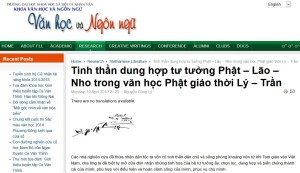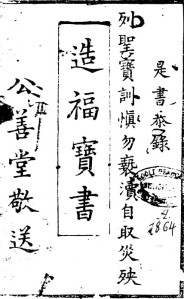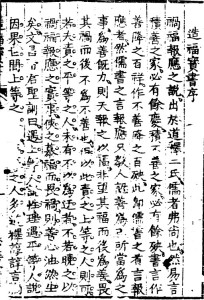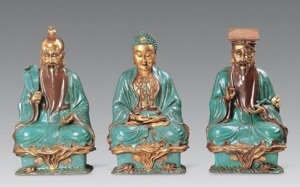One topic about the Vietnamese past that I find is poorly understood is the issue of the “Three Teachings” (Tam giáo) of Buddhism, Daoism and Confucianism.
I just did a Google search for “tam giáo Việt Nam” and randomly chose one of the pages that came up. It was a university web page that contained an essay that had been copied from an academic journal, and this is how it began:
“Researchers have acknowledged that our nation originally established a democratic spirit and began to live at ease from the time that the Three Teachings entered Vietnam. Our forefathers knew to open the doors themselves and to accept the essence of that thought system, to choose, and to absorb and transform [it] into something of our own, that accords with our conditions and living environment, and which serves us.”
(Các nhà nghiên cứu đã thừa nhận dân tộc ta vốn có tinh thần dân chủ và sống phóng khoáng nên từ khi Tam giáo vào Việt Nam, cha ông ta đã biết tự mở cửa đón nhận những tinh hoa của hệ tư tưởng ấy, chọn lọc, dung hợp và biến chúng thành cái của mình, phù hợp với điều kiện và hoàn cảnh sống của mình, phục vụ cho mình.)
These comments are similar to many others that I have read. The ideas here are based on several problematic assumptions: 1) that there were three distinct bodies of thought (Buddhism, Daoism and Confucianism), 2) that these three distinct bodies of thought existed outside of Vietnam first and then had to “enter” (vào), 3) that there was a coherent “nation” (dân tộc) that existed at that time and that people at that time made choices for the benefit of the nation, and 4) that the form that the Three Teachings took in Vietnam was somehow distinct.
The teachings that we call Buddhism, Daoism and Confucianism developed over the centuries in East Asia in interaction with each other. As a result, Buddhists monks in East Asia encouraged children to be filial just as much as Confucian scholars did, as this concept came to be upheld by everyone as an essential moral value.
While it is perhaps acceptable to say that the main developments in the history of Confucian thought occurred within the boundaries of “China,” in at least the first millennium AD the Red River Delta was part of a larger Buddhist and Daoist world, and therefore, it is difficult to say that those teachings “entered Vietnam” when “Vietnam” was part of the world where they developed.
Meanwhile, the idea that people can “choose” (chọn lọc) aspects of cultural traditions (and reject others) is a modern myth. This has been said about the ruling elite in Meiji Japan and the monarchy in nineteenth-century Siam. However, I have yet to see anyone provide any evidence that demonstrates this process. What, for instance, did any of these people choose, and what did they reject? And who exactly did the choosing, and how do we know this?
Then there is the issue of the form that the Three Teachings took in Vietnam. Was it really distinct? In other words, is it correct to call it “ours”? Or was it similar to the form that the Three Teachings took in other places?
The best place to seek an answer to these questions is in historical sources that actually show us the intermixture of the Three Teachings.
Morality books (thiện thư 善書) are a great source for this. The term “morality books” refers to a genre of texts that became popular in “China” during the period of the Song Dynasty. They were texts that were supposedly revealed by spirits (and contacting spirits was something that “Daoists” did), and they encouraged people to follow “Confucian” moral virtues, but they used the logic of karmic retribution/reward (因果報應, 祸福報應, etc.) in encouraging people to do so (“If you do good things, good things will happen to you”).
However, there was an important distinction that was made in morality books about the role of karmic retribution/reward in these books, and that distinction was pointed out by both Chinese and Vietnamese scholars. One Vietnamese scholar who talked about this issue was a man by the name of Đăng Hy Long, a man who wrote a preface to a collection of (Chinese) morality books that was published in Vietnam in 1884, called the Precious Book for Creating Good Fortune (Tạo phúc bao thư 造福寶書).
In his preface, Đăng Hy Long explained that the idea of retribution/reward that one finds discussed in morality books was distinct from that found in the writings of Daoists and Buddhists. As was the case throughout those parts of Asia that employed classical Chinese at that time, Đăng Hy Long did not use terms which were the exact equivalents of terms such as “Buddhism,” “Daoism” and “Confucianism” that are used in vernacular languages today. Instead, he referred to the “Dao” (Đạo 道) and “Sakya” (Thích釋) “clans” (thị 氏), as well as to “Scholars” (Nho giả 儒者), terms which had different connotations (or what we could call a different semantic range), but which nonetheless referred to three basic repertoires of ideas and practices.
Ths is what Đăng Hy Long wrote:
“Talk of calamity, good fortune and retribution/reward emerged first among the Dao and Sakya[muni] clans. [Confucian] scholars did not venerate [these ideas]. However the Classic of Changes [i.e., Yijing 易經] states that ‘Those who accumulate good deeds will have much to rejoice, whereas those who accumulate evil deeds will encounter many calamities.’ The Classic of Documents [i.e., Shangshu 尚書] states that ‘On those who do good are sent down a hundred blessings, and on those who do evil are sent down a hundred calamities.’ This is what the texts of [Confucian] scholars say about retribution/reward.
What the texts of [Confucian] scholars thus say about retribution is that people should recognize goodness as that which they should carry out. When they make efforts to carry out good deeds, Heaven responds by granting good fortune. It is not the case that they first desire good fortune and then carry out good deeds, or that they first fear calamity and then do not engage in evil acts.”
Đăng Hy Long argues here that what we would today call the Three Teachings of Buddhism, Daoism and Confucianism all talk about a similar issue – reward/retribution. However, he clearly thinks that the Confucian approach to this issue is superior, and that Confucian scholars are morally superior to the people who follow other teachings.
Why is this the case? Because, according to Đăng Hy Long, Confucian scholars do good because it is the right thing to do, whereas Buddhists and Daoists first think of something that will bring benefit to them, and then they carry out the acts of goodness necessary to be rewarded with the desired benefit.
In other words, from the perspective of Đăng Hy Long, Buddhists and Daoists are calculating, whereas Confucian scholars are simply morally upright.
This is one view of the Three Teachings. In Buddhist texts one can find a different view, one that emphasizes the superiority of Buddhism. What these views show, however, is that the Three Teachings did not blend into some harmonious whole. Instead, while there were ideas that were shared by everyone in society – such as the importance of filial piety and the concept of reward/retribution – people still differentiated themselves from others, and thought that their own approach to the shared aspects of society were superior.
Such an approach to life is very common. Indeed, thinking that one’s self is better than one’s neighbors or other people in society is a very common human trait. Most people throughout history have not made choices for “our nation,” but instead, have repeatedly emphasized their own perceived self-importance.
When one looks at the Three Teachings through that perspective, we obtain a different picture of the past, but one which is much more closely reflected in the historical record, and which is likely much closer to reality that much of what has been written to date.




There’s strong current of “choosiness” that runs through a lot of fairly recent writing by Vietnamese about the nation and culture. The thrust is that a collective group of people have (or should have) the good sense to chose among activities, behaviors and beliefs in a view that positively define the Vietnamese people. I’ve noticed this a lot in post-đổi mới proclamations of people in government employ (tiếp thụ có chọn lọc). Anyone have an idea when this choosiness really got going? I think it was in 1990s, but maybe it was earlier.
As you were writing these comments, I was filming the video I just made. . . Great minds think alike. 🙂
I’m not sure, but I think the “choosiness” concept got going in the 1990s too, as Vietnam started to “hội nhập” into the larger world.
I think you’re right about it being part of the integration / hội nhập push from the central government. Pre-1990 Vietnam was almost a hermit kingdom. There were visits from Eastern Europeans and Cubans but these visitors were limited in their ability to get around and come into contact with many people. Pre-1990, the authorities could effectively control the information about the outside world that people could come to know about. Post-1990 there was a realization that they couldn’t keep the outside world out, so they should try to shape the terms in which cultural contact takes place.
Thus the party, with the people unanimously behind it (or maybe it’s better to say the people and the party as a united entity) are said chose what information and culture is appropriate to strengthen the nation (the nation being synonymous with the party and the people unanimously behind it). The interesting twist in the text you look at above is this party / people complex is projected into the distant past. The party / people are at one with the people of antiquity. This has become a two way proposition – the Vietnamese nation since antiquity has always been “choosy,” thus we, the Vietnamese nation of the present are by nature choosy. And if you come into contact with outside information and culture in such a way that is not choosy you are betraying a 4000 year mandate, thus betraying your nation.
There was just a case where a young singer songwriter Sơn Tùng presented a song that the government ministry in charge of copyright enforcement decided had plagiarized a K-Pop song. If you listen to the two songs there is definite similarity in instrumentation, but the melodies of the Vietnamese and Korean songs are clearly distinct and different. The Koreans themselves acknowledged there was no plagiarism. But I think the song remains banned for this infraction, and I think the reason is the cultural authorities wanted to punish an example of the wrong kind of choosiness. And of course the authorities have Hùng Vương on their side.
Yea, in terms of the world of historical scholarship, it’s pretty clear to me. In “entering” the world, there has been a very careful effort to not enter the American world. A few days ago there was a conference in Hanoi that highlighted the contributions that the EFEO has made to the world’s understanding of Vietnam and its history. There is no question but that EFEO scholars did do this. There is also no question but that their scholarship has been (and continues to be) extremely conservative. And it is therefore safe to “choose” to deal with the EFEO.
In looking at information and pictures about that conference on the Internet, however, I tried to imagine a conference that highlighted the contributions of American scholars toward the world’s understanding of Vietnam and its history. . . I don’t think American scholars have done anything that compares with the work of French scholars on Champa and Angkor, but when it comes to Vietnamese history (particularly the modern period), the contributions are significant. But will there be a conference that highlights this fact? I certainly don’t anticipate anything like that in my lifetime. 🙂
In any case, it’s interesting to see how countries deal with their colonial pasts. In Taiwan, local Taiwanese dislike for KMT rule after WW II led to a nostalgia for, or a romanticization of, the Japanese colonial period. In the case of Vietnam, I suspect that it’s a combination of the War and the fact that the US is still a global power that somehow makes it “dangerous” whereas France (and 70 years of French colonial rule) is not. The fact that scholarship in the US is more critical and hard-hitting than a lot (but by no means all) French scholarship (but certainly more so than the scholarship that one finds in the Bulletin de l’EFEO) then adds to that sense that American knowledge is something that you definitely do not want to choose.
C’est la vie.
But in the realm of choosiness, the domain of scholarship is relatively small potatoes. Cultural and technological imports I think loom much larger. How should the Vietnamese nation best “choose” the internet? Obviously with a firewall. Also by encouraging the demise of Yahoo 360 (a tremendous resource for free inquiry in Vietnam while it lasted) and then creating home-based blogging platforms that can be better managed. They probably also employ people to create and edit wikipedia pages.
In culture, of course, there are choices made (on behalf of the nation, upholding the will and legacy of Hùng Vương and Trần Hưng Đạo) about what works can be broadcast, published and distributed. But I think the greater concern is not what foreigners are doing in foreign languages (about which there is a general lack of interest) but what appears in Vietnamese, and what is presented as Vietnamese (especially in Vietnamese to the VIetnamese). Your writings would not cause a ripple if they were not translated. (I’ve heard American gangster rap with non-stop expletives on Saigon radio).
I think the main area where choosiness applies is in the audiovisual (keeping making those videos, but do them in Vietnamese if you want to make waves). There is a big question about the place of feminine pulchritude in Vietnamese performance and film where it’s apparent that the bureaucrats (with support of 4000 năm văn hiến) making one choice (the proper choice) and a large segment of the population making another more libidinally inspired (and improper) choice. Or the borrowings of visual and melodic styles in contemporary pop music and music videos. And it’s interesting that in this arena borrowing from America is not seen as the worst choice. The greatest disapproval arises from borrowing from the pop culture of Korea and China.
But behind all of this is a tremendous (mostly official) anxiety that the Vietnamese essence is being lost, even destroyed. It’s interesting to observe what is considered to be essential. Sometimes it’s political in nature. Often it’s cultural. Per your video, they seem to have taken knives, forks and spoons in stride. Young women in bikinis on broadcast TV seems to be mostly OK? (Somehow, the beauty pageant has a real attraction and resonance for many Vietnamese). Singing an uplifting rock song with a pentatonic scale, definitely cool. Singing Vietnamese words to song that resembles a Kpop or Mandopop song – a definite taboo.
Did you follow the scandal from last year with this video?
http://taybui.blogspot.com/2014/01/anh-khong-oi-qua-i-wouldnt-ask-for.html
How did I miss this??? That must have been when I was living in a cave. . .
Thanks for pointing out the Korean and Chinese connections. As for me, as soon as the woman took off her coat I immediately thought of the video for the Jennifer Lopez song, “Love Don’t Cost a Thing.”
Yea, and to respond to some of your ideas. . . at the moment I don’t think that there is a model for “hip academic videos.” So I’m trying to figure out what that might be, but I suspect that it’s more culturally specific than text.
At one level, video can be universal. An attractive young woman walking down the street taking her clothes off (from Jennifer Lopez to Amanda Baby) is going to be popular among a certain population. On another level though, that’s probably not the best way to “hook” people into an academic topic.
So what is?
I had a conversation last summer with some young people in Hanoi about making videos. What I quickly learned is that we had very different ideas about what such a video should look like. I was thinking of Anthony Bourdain’s “No Reservations” (which I modeled the Trung Sisters videos after), and I’m not sure what they were thinking of, but it was more like the kind of slapstick humor that you can find on Japanese/Korean TV.
This could be a generational difference, or it could be a cultural difference, but if I were to make any of the videos that I just made in Vietnamese, I don’t think that they would “make waves,” other than a small ripple at the novelty of an ong Tay making a video in Vietnamese (what I call “the talking horse phenomenon”), because the aesthetic sensibilities and sense of humor are different. To be fair, there must be ong Tay out there who are attuned enough to Vietnamese ways to be able to create something that can be appreciated in a Vietnamese context, but I don’t have that ability.
So for now, I’m just going to try to figure out what a “hip academic video” might look like. I think I’ve got a long ways to go. . . but it is fun. 🙂
I would say you’re doing alright on the academic hipness scale. After all, how hip can something academic be? Only suggestion I can suggest is to somehow grab ahold of or run with a meme, or (if you’re really ambitious) create a meme. The ideal would be to create some of contagion for an idea or an image.